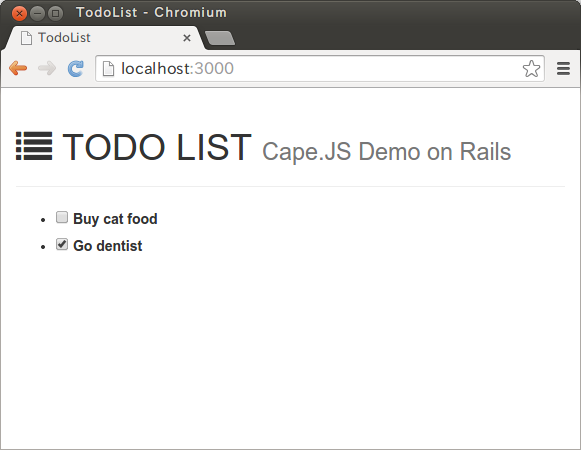Let the component have the date - Cape.JS Primer
On the previous lecture, I explained the step to mount Cape.JS to Ruby on Rails.
The theme of this lecture is relation of the component and the data.
Our goal is to develop the easy Web “To-do list” application. It handles the collection of “tasks (things to do). It’s better to express this kind of data by object’s array.
obj = { x: 1, y: 2 }; obj["z"] = 3, the object obj holding a pair of 3 properties and value is made. You can also obj["z"] as obj.z.
Let’s express the object like following of each task.:
{ title: "Buy cat food", done: false }
Then, the array of the object becomes “list of tasks”.
[
{ title: "Buy cat food", done: false },
{ title: "Go dentist", done: true }
]
By the way, I’ll introduce how to update Cape.JS before I’ll come to the point.
Today(2015/06/07)、Cape.JS 1.1.0 was released. It’s better to use the newest one so upgrade Cape.JS of “To-do list”.
Open bower.json on the text editor,
"capejs": "~1.0.0",
rewrite above to the one following below.
"capejs": "~1.1.0",
Then, run bower install on terminal.
So, let’s let the component of Cape.JS have the array of tasks. Rewrite app/assets/javascripts/todo_list.es6 as following on the text editor.
class TodoList extends Cape.Component {
init() {
this.tasks = [
{ title: "Buy cat food", done: false },
{ title: "Go dentist", done: true }
];
this.refresh();
}
render(m) {
m.ul(m => {
this.tasks.forEach(task => {
m.li(m => {
m.label(m => {
m.input({ type: 'checkbox', checked: task.done }).sp();
m.span(task.title);
});
});
});
});
}
}
When you define the name of instance method as init to the component class, this method is run just after the component is mount.
I set the array of tasks to the property tasks here. It calls the method refresh at the end of the method. It indicates to redraw to the component. As the result, it calls the method render and the screen of the browser changes. If the method init doesn’t exist on the component, it calles this.refresh() in the back. But if you define the method init, be careful that the screen of the browser doesn’t display anything unless it calls this.refresh() even if it mounts the component.
init after the method, doesn't it? That is because Ajax call is supposed to run in the method init and the date is supposed to be initialized. Ajax call is literally "synchronous" so it finishes after running the method init. So, the data won't be organized even calling this.refresh() after the method init. This situation around here will be clear as you keep studying.
The content of the method render changes very much. It calls the method forEach to the array this.tasks and runs loop processing. The object like the parameter like { title: " To buy cat's feed ", done: false } is set to the parameter task in order. Then, it creates checkbox and text by referring the value this task.
m.input({ type: 'checkbox', checked: task.done }).sp();
m.span(task.title);
So, let’s try whether it works well. Reload the browser. When the screen like below displays, it’s OK.

It’s like more application. That’s all for today. On the next lecture, I’ll explain how to initialize the data of the component by using Ajax.